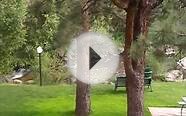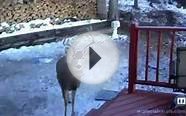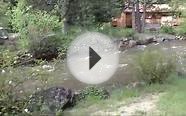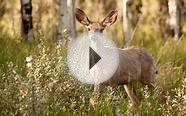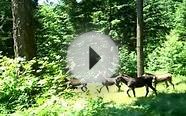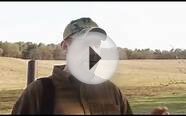Types of Deer in Colorado
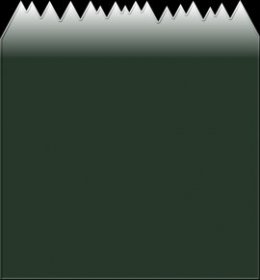 Mule Deer (AKA: Mulies, Black-tailed Deer) Odocoileus hemionus Description: A member of the Cervidae family also including elk and moose. Mule deer get a little larger than their closely related cousins, the white-tailed found on Colorado’s eastern plains. They weigh between 100 to 475 lbs. Their coats range from a reddish brown in the summer months to a grayish brown in the winter months. The muzzle, throat, and rump are all white. The tail is thin and white with a black tip. Their ears are very large, generally with black tips, edges and white on the inside. Males or bucks, have antlers with 2 main beams and tines (points) coming of the beams. The antlers project forward and up from the bucks head. A 5-6 point buck is on the large and older side. The antlers are shed annually from February to March. Females or does do not grow antlers and do not get as large as the bucks. Mule deer generally live for about 10-15 years. (Tekiela, 2007) Origin & Range: Native to Colorado and found state wide. Mule deer are found throughout most of the western half of North American, from the northern reaches of Canada all the way south into Mexico. Colorado has one of the highest population densities of mule deer found in all of the United States. (Fitzgerald, Meaney, and Armstrong, 1994). Habitat: Found at nearly all elevations in Colorado. From to, these animals are found in every type of ecosystem that Colorado has to offer! The greatest population densities are found in shrubland terrain that is rough and broken, offering both cover and an abundant food source (Fitzgerald, Meaney, and Armstrong, 1994). Around Durango, mule deer can be seen just about anywhere that you happen to venture outside, including in the town of Durango itself. Just a few common trails to see them on include the Animas River Trail, Telegraph, Overend Mountain Park, Animas Mountain Park, and the Colorado Trail. Diet: Mule deer are herbivores, eating a bulk of their diet as twigs and buds on trees and shrubs. They will also eat some grass and forbs as well. Their diet consists mostly of twigs and buds from woody plants during winter months and a little more of grasses and forbs during summer months. Being primarily a browser (feeding on woody plants like trees and shrubs) they do little competing with livestock or elk for food. (Armstrong, 2011) Reproduction: The breeding season occurs from late November to early December. Mule deer are highly polygamous. Sparring between bucks is common during the rut (breeding season). The more dominate males get breeding rights with a harem of females within an area. The gestation (pregnancy) period for a doe is between 6-7 months, with new baby fawns being born from May to June. Yearling does generally give birth to only a single fawn where as does who are older and in good condition often produce twins. The does are solitary during birthing. Fawns are covered with white spots and can walk within hours after their birthing! They generally start eating plants in a few weeks but are not weaned from the mothers milk until fall. General Information: “Mule Deer have a unique, stiff-legged bounding gait called stotting, in which the front and hind legs move in the same fashion at the same time. Stotting helps to positively identify this animal since White-tailed Deer do not do this (Tekiela, 2007).” References Armstrong, D. (2009, September 30). Deer. Retrieved from J., Meaney, C., & Armstrong, D. (1994). Mammals of Colorado. Niwot, CO: The Denver Museum of Natural History. Tekiela, S. (2007). Mammals of Colorado field guide. Adventure Pubns.
Mule Deer (AKA: Mulies, Black-tailed Deer) Odocoileus hemionus Description: A member of the Cervidae family also including elk and moose. Mule deer get a little larger than their closely related cousins, the white-tailed found on Colorado’s eastern plains. They weigh between 100 to 475 lbs. Their coats range from a reddish brown in the summer months to a grayish brown in the winter months. The muzzle, throat, and rump are all white. The tail is thin and white with a black tip. Their ears are very large, generally with black tips, edges and white on the inside. Males or bucks, have antlers with 2 main beams and tines (points) coming of the beams. The antlers project forward and up from the bucks head. A 5-6 point buck is on the large and older side. The antlers are shed annually from February to March. Females or does do not grow antlers and do not get as large as the bucks. Mule deer generally live for about 10-15 years. (Tekiela, 2007) Origin & Range: Native to Colorado and found state wide. Mule deer are found throughout most of the western half of North American, from the northern reaches of Canada all the way south into Mexico. Colorado has one of the highest population densities of mule deer found in all of the United States. (Fitzgerald, Meaney, and Armstrong, 1994). Habitat: Found at nearly all elevations in Colorado. From to, these animals are found in every type of ecosystem that Colorado has to offer! The greatest population densities are found in shrubland terrain that is rough and broken, offering both cover and an abundant food source (Fitzgerald, Meaney, and Armstrong, 1994). Around Durango, mule deer can be seen just about anywhere that you happen to venture outside, including in the town of Durango itself. Just a few common trails to see them on include the Animas River Trail, Telegraph, Overend Mountain Park, Animas Mountain Park, and the Colorado Trail. Diet: Mule deer are herbivores, eating a bulk of their diet as twigs and buds on trees and shrubs. They will also eat some grass and forbs as well. Their diet consists mostly of twigs and buds from woody plants during winter months and a little more of grasses and forbs during summer months. Being primarily a browser (feeding on woody plants like trees and shrubs) they do little competing with livestock or elk for food. (Armstrong, 2011) Reproduction: The breeding season occurs from late November to early December. Mule deer are highly polygamous. Sparring between bucks is common during the rut (breeding season). The more dominate males get breeding rights with a harem of females within an area. The gestation (pregnancy) period for a doe is between 6-7 months, with new baby fawns being born from May to June. Yearling does generally give birth to only a single fawn where as does who are older and in good condition often produce twins. The does are solitary during birthing. Fawns are covered with white spots and can walk within hours after their birthing! They generally start eating plants in a few weeks but are not weaned from the mothers milk until fall. General Information: “Mule Deer have a unique, stiff-legged bounding gait called stotting, in which the front and hind legs move in the same fashion at the same time. Stotting helps to positively identify this animal since White-tailed Deer do not do this (Tekiela, 2007).” References Armstrong, D. (2009, September 30). Deer. Retrieved from J., Meaney, C., & Armstrong, D. (1994). Mammals of Colorado. Niwot, CO: The Denver Museum of Natural History. Tekiela, S. (2007). Mammals of Colorado field guide. Adventure Pubns.
You might also like
